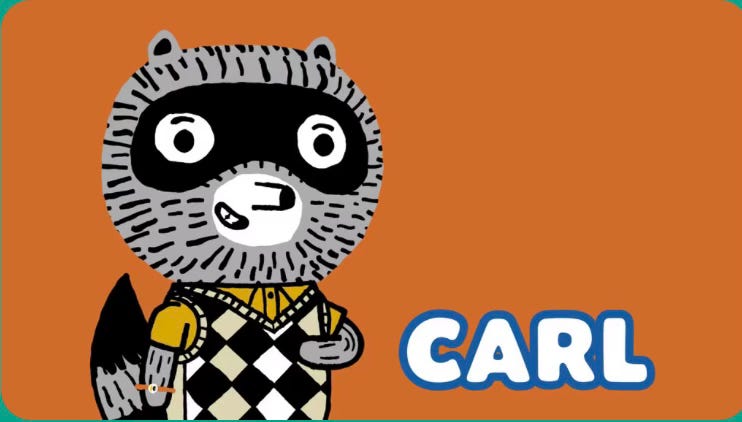My kids knew about a new show coming out before me, in the way that young people usually do. My oldest had read about it in The Week Junior.
“Mom there’s a show coming on PBS about neurodivergence, it’s about kids like us.”
Kids like us—our merry band of neurodivergent humans. Our family is full of neurodiverse beauty—autism, ADHD, and giftedness to name a few brain constellations. There are a lot of unique needs, challenges, and strengths in this crew of ours. We joke that everyone’s neurodivergence pings off of each other. For all their differences, they all share an appreciation for Carl, the autistic raccoon.

Carl the Collector is an animated show on PBS Kids about the “everyday adventures of Carl, a warm-hearted autistic raccoon who enjoys collecting things and loves his friends and family in Fuzzytown. “
“CARL THE COLLECTOR spotlights neurodiverse characters while exploring and celebrating the entire spectrum of humanity,” said Creator and Executive Producer, Zachariah OHora. “The world of Fuzzytown is designed to be a place where all viewers will see themselves or someone they know in it. We hope Carl and his friends will encourage empathy and understanding, and ultimately show that everyone benefits when we recognize and embrace our differences.”
CARL THE COLLECTOR, PBS KIDS’ First Series Centering on an Autistic Main Character, Premieres Nov 14
“Viewers see themselves”
Let me set the scene for the premiere of Carl the Collector in the Barbash house. I’ve recently had shoulder surgery, so the kids are sitting in front of the television in our bedroom where I am sitting in my couch “nest” to protect my shoulder from any unintentional bumps. All four kids are watching the screen. One of my kids is jumping up and down, saying “This show is about US!.” There are smiles. Commentary includes how they like the animation because it looks like Wolfie the Bunny *, a favorite book. Why yes—it’s Zachariah Ohora after all. And one of the kids says, “oh yeah, I do that” in reaction to one the characters.
I didn’t expect tears. They were mine. I didn’t know how much it would mean to hear the character, Carl, inform his friend that he is autistic. I didn’t know how much it would mean to watch my children see themselves on the screen (I mean, their neurodivergent animal creature selves).
Mirrors, windows, and sliding Doors
Some may be familiar with Rudine Sims Bishop, who wrote about the importance of children having access to mirrors, windows, and sliding doors in literature. Her original writing on the topic was about representation in books but the concept applies across media.
“We need diverse books because we need books in which children can find themselves, see reflections of themselves. I wrote a piece, maybe 1990 it was published which I called “Mirrors, Windows, and Sliding Glass Doors.” And I think that's really why we — children need to see themselves reflected. But books can also be windows. And so you can look through and see other worlds and see how they match up or don't match up to your own. But the sliding glass door allows you to enter that world as well. And so that's the reason that the diversity needs to go both ways. I mean it's not just children who have been underrepresented and marginalized who need these books. It's also the children who always find their mirrors in the books and, therefore, get an exaggerated sense of their own self-worth and a false sense of what the world is like because it's becoming more and more colorful and diverse as time goes on.”
Rudine Sims Bishop
Interview Clip (view clip here.)
I witnessed a mirror being shown to my children. And it was overwhelming. I was grateful and delighted. I was also sad because it takes a lot to get it done right. Part of what is unique about this particular show is not just the representation of neurodivergence on the screen, but how they are making this show. The team making this show includes autistic writers and autistic actors voicing the autistic characters of Carl and Lotta.
I was most surprised by my feeling of urgency after witnessing this moment. The sense of urgency that every child deserves a mirror...yesterday. Most well-meaning people know this on a cognitive level. We nod our heads yes in agreement when we read about inclusivity in media but there is something about knowing it deep in your bones.
The more mirrors we have, the more windows that appear for others. They have seemingly different purposes—a mirror to reflect an image to the observer and a window to allow an observer to look out, but they both involve light.
Light is needed to see yourself and to see others. Light to see worth, value, and beauty. Light to support curiosity, respect, and connection.
We need all the light we can possibly find right now.

More on mirrors, windows, and sliding doors
There is more to be said here about how to help children (and adults, too) access mirrors and windows. I’ve decided to break it up and explore more in future posts. If you have ideas that you would like explored that may shape future posts, send me a message by replying directly to this email or you can contact me here.







This moved me to tears. I’m so glad your children were able to see themselves. I don’t think we realize how badly we want it until we finally see it. To many more mirrors!
This makes my heart explode in the best way. I’m one of the advisors for this show, and it has been the privilege of a lifetime to work on it —, I’m going share this with the rest of the Carl team. ❤️